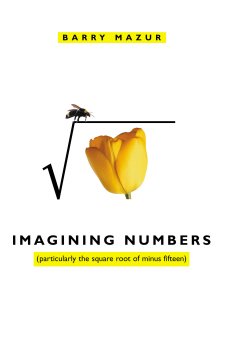Take a Journey Inside Your
Imagination…
IMAGINING NUMBERS (particularly the square root of minus fifteen) Barry Mazur
It’s easy to imagine physical things—but what comes to mind when we think about numbers? Celebrated mathematician Barry Mazur brings math to life by contrasting the way we read literature with the way we understand numbers. IMAGINING NUMBERS (particularly the square root of minus fifteen) is an invitation to those who take delight in the creative work of reading poetry but may have no background in math, to take a leap of the imagination in mathematics. Imaginary numbers entered into mathematics in sixteenth-century Italy and were used with immediate success, but nevertheless presented an intriguing challenge to the imagination. It took more than two hundred years for mathematicians to discover a satisfactory way of "imagining" these numbers. Mazur presents us with a fascinating exploration of how we comprehend and develop ideas both in poetry and in math, from the Renaissance through to the present day, and provides us with a step-by-step guide to how we can begin imagining numbers for ourselves. Barry Mazur does his mathematics at Harvard University, where
he is Gerhard Gade University Professor. One of the most renowned pure
mathematicians working today, his work proved vital in the solution of
Fermat’s last theorem. He lives in Cambridge, Massachusetts, with his wife,
the writer Grace Dane Mazur.
IMAGINING NUMBERS will be published by Farrar, Straus and Giroux on February 20, 2003. Price: $22.00 / ISBN: 0-374-17469-5 For more information, please contact: Kim Hilario at (212) 206-5306 or Kim.Hilario@fsgbooks.com
ADVANCE PRAISE FOR IMAGINING NUMBERS BY BARRY MAZUR
"Barry Mazur’s Imagining Numbers is quite literally a charming book; it has brought even me, in a dazed state, to the brink of mathematical play." "This absorbing and in itself most imaginative book lies in the grand tradition of explanations of what mathematical imagination is—such as those of Hogben, Kasner and Newman, and Polya's How to Solve It. But it is unique in its understanding of and appeal to poetic thought and its analogues, and will appeal particularly to lovers of literature." "A very compelling, thought-provoking, and even dramatic description of what it means to think mathematically." "A clear, accessible, beautifully written introduction not only to imaginary numbers, but to the role of imagination in mathematics." |
